Itō Chūta
Itō Chūta (伊東 忠太, 26 October 1867 – 7 April 1954) was a Japanese architect, architectural historian, and critic. He is recognized as the leading architect and architectural theorist of early 20th-century Imperial Japan.[1]
Itō Chūta 伊東忠太 | |
|---|---|
.jpg) Pictured in May 1954 edition of International Architecture (国際建築, Kokusai kenchiku) | |
| Born | 26 October 1867 |
| Died | 7 April 1954 Bunkyō, Tokyo |
| Nationality | |
| Alma mater | Imperial University |
| Occupation | Architect |
| Awards | Order of the Sacred Treasure Order of Culture |
| Practice | Japan Art Academy (final) |
| Buildings | Tokyō University of Commerce Tsukiji Hongan-ji Kanematsu Auditorium at Hitobashi University |
Biography
Second son of a doctor in Yonezawa, present-day Yamagata Prefecture, Itō was educated in Tokyo.[2] From 1889 to 1892 he studied under Tatsuno Kingo in the Department of Architecture at the Imperial University.[1] Josiah Conder was still teaching in the department, while Ernest Fenollosa and Okakura Kakuzō were also influential in the formation of Itō's ideas.[1][3] For graduation he designed a Gothic cathedral and wrote a dissertation on architectural theory.[1] His doctoral thesis was on the architecture of Hōryū-ji.[1][4] He was professor of architecture at the Imperial University from 1905, then of Waseda University from 1928.[5]
Itō travelled widely, to the Forbidden City with photographer Ogawa Kazumasa in 1901 and subsequently, after fourteen months in China, to Burma, India, Sri Lanka, Turkey, Europe and the United States.[2][5][6] Later he was involved in the planning of Chōsen Jingū in Seoul and a survey of the monuments of Jehol in Manchukuo.[7][8] He incorporated elements of the diverse architectural styles he encountered in his many writings and approximately one hundred design projects.[5][9] He was also a leading proponent of the Imperial Crown style of architecture, which had been developed for the Japanese Empire by architect Shimoda Kikutaro.[10][11]
Itō helped formulate the Ancient Temples and Shrines Preservation Law of 1897, an early measure to protect the Cultural Properties of Japan.[12] He is also credited with coining the Japanese term for architecture, namely kenchiku (建築) (lit. 'erection of buildings') in place of the former zōkagaku (造家学) (lit. 'study of making houses').[2] A member of the Japan Academy, in 1943 he was awarded the Order of Culture.[1][5] Itō has more recently been criticised, with specific reference to his writings on Ise Grand Shrine, for having 'blurred a religio-political discourse with an architectural discourse'.[13]
Projects
| Project | Date | Location | Comments | Image | |
|---|---|---|---|---|---|
| Heian Jingū[2][14] | 1895 | Sakyō-ku, Kyoto | recreation on a smaller scale of the Daikokuden (Great Hall of State) of the ancient capital of Heian-kyō; Itō worked with fellow architect Kiko Kiyoyoshi, drawing on his studies of old records and picture scrolls | ||
| Asano Sōichirō pavilion (浅野総一郎邸)[15] | 1909 | Tokyo | Japanese-style pavilion; destroyed in the Great Kantō earthquake | ||
| Niraku Villa (二楽荘, Nirakusō)[5][16] | 1910 | Kobe, Hyōgo Prefecture | for Ōtani Kōzui, one of the pioneering explorers of Central Asia and the Silk Road; destroyed by arson on 18 October 1932; to the north of Konan University; photographic documentation exists | ||
| Asoka Shinryōjo[17][18] | 1912 | Shimogyō-ku, Kyoto | for the Shinshū Believers Life Insurance Company; now the Hongan-ji Dendo'in; Municipal Cultural Property | 34°59′28.9″N 135°45′14.3″E | |
| Main Gate (正門, Seimon), Tokyo Imperial University[19][20] | 1912 | Bunkyō, Tokyo | replacement for the Edo-period Akamon, moved to one side; Emperor Meiji was the first to ride through, on graduation day 1912; Itō was professor at the University from 1905; Registered Tangible Cultural Property | ||
| Meiji Jingū[2] | 1920 | Shibuya, Tokyo | shrine to Emperor Meiji; destroyed in the Tokyo air raids of World War II; rebuilt in 1958 following the original design | 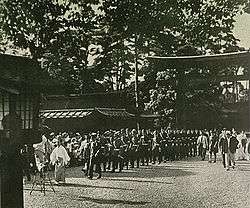 | |
| Uesugi Jinja (上杉神社)[21] | 1923 | Yonezawa, Yamagata Prefecture | rebuilding after a great fire in 1919 that destroyed over a thousand buildings; in the city of Itō's birth |  | |
| Great Hall (大殿, Daiden), Zōjō-ji[5][22] | 1925 | Minato, Tokyo | an earlier hall was lost in a fire in 1873 and its replacement in a fire in 1909; Itō's hall was destroyed in 1945; the Great Hall was rebuilt in 1978 | ||
| Tekigai Villa (荻外荘, Tekigaisō)[5] | 1927 | Suginami, Tokyo | for Prime Minister Fumimaro Konoe, founder of the Taisei Yokusankai movement |  | |
| Gion Kaku (祇園閣)[23] | 1927 | Higashiyama-ku, Kyoto | 34 m; in Gion; Registered Tangible Cultural Property |  | |
| Ōkura Shūkokan (大倉集古館)[2][24][25][26] | 1927 | Minato, Tokyo | rebuilding after the Great Kantō earthquake; houses the Ōkura Museum of Art with a collection that includes three National Treasures; Registered Tangible Cultural Property | 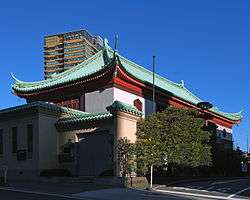 | |
| Kanematsu Auditorium (兼松講堂, Kanematsu kōdō)[24][27] | 1927 | Kunitachi, Tokyo | Romanesque Revival style; part of Hitotsubashi University; Registered Tangible Cultural Property | 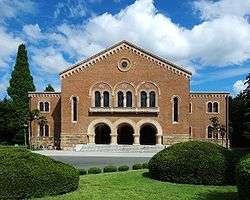 | |
| Former Hankyū Umeda Station Concourse (旧阪急梅田駅地上駅コンコース)[28] | 1929 | Kita-ku, Osaka | with dome, gilding, chandeliers, and arabesque | 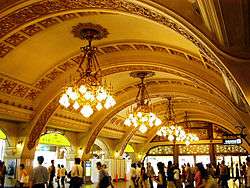 | |
| Tokyo Memorial Hall (東京都慰霊堂, Tōkyōto ireidō)[24][29] | 1930 | Sumida, Tokyo | Dedicated to 58,000 victims of the Great Kantō earthquake of 1 September 1923 and 105,000 victims of the bombing of Tokyo on the night of 9/10 March 1945 |  | |
| Tokyo Reconstruction Memorial Hall (東京都復興記念館, Tōkyōto fukkō kinenkan)[24] | 1931 | Sumida, Tokyo | houses exhibits relating to reconstruction after the Great Kantō earthquake; located in Yokoamichō Park near the Tokyo Memorial Hall | 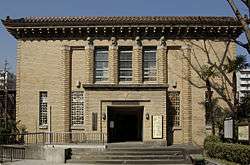 | |
| Yūshūkan[24] | 1931 | Chiyoda, Tokyo | rebuilding after the Great Kantō earthquake; museum of Yasukuni Jinja | 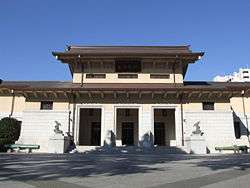 | |
| Shōgyōden (聖教殿), Hokekyō-ji[24] | 1931 | Ichikawa, Chiba Prefecture | reinforced concrete structure to house temple treasures, including texts by Nichiren, founder of the Nichiren School (On Establishing the Correct teaching for the Peace of the Land and The Object of Devotion for Observing the Mind) | 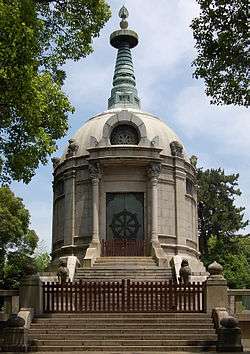 | |
| Sōji-ji Daisodo[30] | 1933 | Tsurumi-ku, Yokohama | Monks' training center |  | |
| Shinmon (神門), Yasukuni Jinja[31][32] | 1934 | Chiyoda, Tokyo | reminiscent of the shinmei-zukuri style of the Ise Grand Shrine | 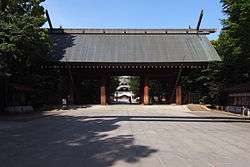 | |
| Tsukiji Hongan-ji[2][24][33] | 1934 | Chūō, Tokyo | rebuilding after the Great Kantō earthquake; evokes chaitya no.9 at the Ajanta Caves; near the Tsukiji fish market; Registered Tangible Cultural Property |  |
|
| Haiseiden (俳聖殿)[34] | 1942 | Iga, Mie Prefecture | for the 300th anniversary celebrations of the birth of Matsuo Bashō; in the grounds of Iga Ueno Castle; Important Cultural Property | 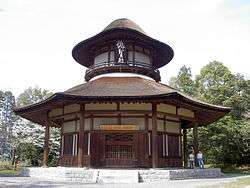 | |
See also
| Wikimedia Commons has media related to Itō Chūta. |
References
- Watanabe Toshio (2006). "Japanese Imperial Architecture: from Thomas Roger Smith to Itō Chūta". In Conant, Ellen P (ed.). Challenging past and present: the metamorphosis of 19th-century Japanese art. University of Hawaii Press. pp. 240–253. ISBN 978-0-8248-2937-7.
- Tai Kawabata (23 April 2003). "Chuta Ito: A builder of dreams". The Japan Times. Retrieved 24 February 2012.
- Suzuki Yuichi (1984). "A Study on Chuta Itoh's architectural idea: influence on Chuta Itoh's artistic idea of E. F. Fenollosa and Tensin Okakura". Summaries of Technical Papers of Annual Convention (in Japanese). Architectural Institute of Japan. 59: 2703–4.
- Finn, Dallas (1995). Meiji Revisited: The Sites of Victorian Japan. Weatherhill. pp. 167f. ISBN 0-8348-0288-0.
- "伊東忠太 (建) 昭和29年4月7日没". National Research Institute for Cultural Properties, Tokyo. Archived from the original on 19 October 2012. Retrieved 24 February 2012.
- "Scenes from Late Qing Dynasty China: Photographs by Ogawa Kazumasa, Hayasaki Kokichi and Sekino Tadashi". Tokyo National Museum. Retrieved 25 February 2012.
- Aoi Akihito (1999). "Selection of the site for the Chōsen Shrine 1912–1918: Its relations to development of Japanese settlement and the early urban improvement in Keijo (Seoul)". Journal of architecture, planning and environmental engineering. Transactions of AIJ (in Japanese). Kobe Design University. 521: 211–8.
- Tanaka Sadahiko (2003). "The investigation and preservation activities of the heritage of Jehol in Manchukuo: Cross-cultural understanding through the investigation and preservation activities of historical buildings in Japanese colony". Journal of architecture, planning and environmental engineering (in Japanese). Agency for Cultural Affairs. 569: 201–8.
- "伊東忠太". Yamagata Prefecture. Retrieved 25 February 2012.
- Alistair Fair (3 March 2016). Setting the Scene: Perspectives on Twentieth-Century Theatre Architecture. Taylor & Francis. pp. 101–. ISBN 978-1-317-05691-1.
- Francis Chia-Hui Lin (9 January 2015). Heteroglossic Asia: The Transformation of Urban Taiwan. Taylor & Francis. pp. 85–. ISBN 978-1-317-62637-4.
- Coaldrake, William Howard (1996). Architecture and Authority in Japan. Routledge. p. 248. ISBN 0-415-05754-X.
- Zhongjie Lin (2010). Kenzo Tange and the Metabolist movement: urban utopias of modern Japan. Routledge. p. 67 (quoting Jonathan M. Reynolds). ISBN 978-0-415-77659-2.
- "Heian-jingu Shrine". Kyoto City. Retrieved 24 February 2012.
- Finn, Dallas (1995). Meiji Revisited: The Sites of Victorian Japan. Weatherhill. p. 191. ISBN 0-8348-0288-0.
- "大谷光瑞と二楽荘". Kobe City. Retrieved 25 February 2012.
- Finn, Dallas (1995). Meiji Revisited: The Sites of Victorian Japan. Weatherhill. pp. 200f. ISBN 0-8348-0288-0.
- "京都市指定・登録文化財-建造物 – 本願寺伝道院". Kyoto City. Retrieved 24 February 2012.
- Finn, Dallas (1995). Meiji Revisited: The Sites of Victorian Japan. Weatherhill. pp. 242f. ISBN 0-8348-0288-0.
- "東京大学本郷正門及び門衛所". Agency for Cultural Affairs. Retrieved 24 February 2012.
- "上杉神社". Yonezawa City. Archived from the original on 18 March 2013. Retrieved 25 February 2012.
- "増上寺の歴史". Zōjō-ji. Archived from the original on 22 February 2012. Retrieved 25 February 2012.
- "祇園閣". Agency for Cultural Affairs. Retrieved 24 February 2012.
- Watanabe Hiroshi (2001). The Architecture of Tōkyō. Edition Axel Menges. ISBN 3-930698-93-5.
- "Okura Museum of Art – outline". Okura Museum of Art. Archived from the original on 27 November 2010. Retrieved 24 February 2012.
- "大倉集古館陳列館". Agency for Cultural Affairs. Retrieved 24 February 2012.
- "一橋大学兼松講堂". Agency for Cultural Affairs. Retrieved 24 February 2012.
- "旧梅田駅コンコース". Hankyu Railway. Retrieved 25 February 2012.
- "東京都慰霊堂". Tokyo Memorial Association. Retrieved 24 February 2012.
- "Sojiji". A Guide to Kamakura. Asahi net. March 2012. Archived from the original on March 4, 2012. Retrieved March 14, 2012.
- "神門". Yasukuni Jinja. Archived from the original on 16 April 2012. Retrieved 25 February 2012.
- "米沢市出身故伊東忠太工学博士設計による建築物 (築地本願寺本堂、湯島聖堂、靖国神社神門)". Yamagata Prefecture. Retrieved 25 February 2012.
- "築地本願寺本堂". Agency for Cultural Affairs. Retrieved 24 February 2012.
- "俳聖殿". Agency for Cultural Affairs. Retrieved 20 February 2012.
External links
(in Japanese) CiNii Article Finder for publications by and about Itō Chūta